Black Pagoda lipstick plants are beautiful and surprisingly easy to care for. In this post, I’m going to tell you all you need to know in order to have the best success.
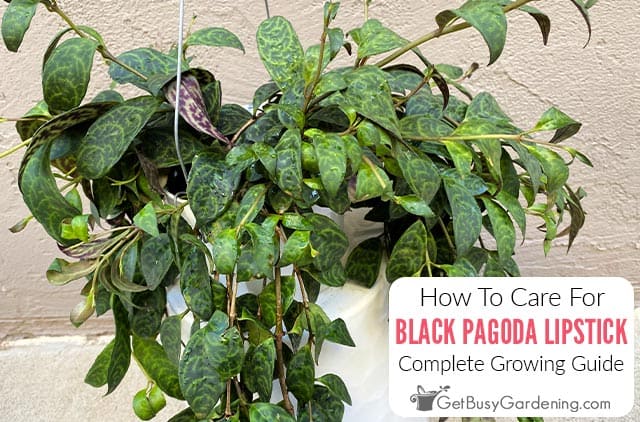
The unique foliage and easy-care nature of a Black Pagoda lipstick plant makes it the perfect houseplant for beginners.
But it’s important to first know how to keep it healthy. This guide is designed to help you learn how to provide the best Black Pagoda lipstick plant care.
You’ll understand how much light, water, and fertilizer it needs, plus how to propagate, prune, and so much more.
Quick Black Pagoda Lipstick Plant Care Overview
| Scientific name: | Aeschynanthus ‘Black Pagoda’ |
| Classification: | Tropical plant |
| Common names: | Zebra Basket Vine, Lipstick Plant ‘Black Pagoda’ |
| Hardiness: | Zones 10-11 |
| Temperature: | 65-80°F |
| Flowers: | Orange, red, yellow, blooms late winter-spring |
| Light: | Full shade, moderate light indoors |
| Water: | Allow soil to dry between waterings, do not overwater |
| Humidity: | Average to high |
| Fertilizer: | General purpose plant food spring-summer |
| Soil: | Chunky, fast-draining, loose |
| Common pests: | Mealybugs, spider mites, scale, aphids, whiteflies, thrips |
Information About Black Pagoda Lipstick Plant
Aeschynanthus ‘Black Pagoda’ is a type of lipstick plant native to tropical regions of SE Asia. It’s an epiphyte that can absorb water and nutrients from the surfaces and air around it.
Unlike the more common variety, this one has flexible, trailing green stems that brown and stiffen with maturity.
The leaves feature creamy mottling and purple undersides, which earned it the nickname zebra basket vine.
They typically reach between 1-2’ in size, and are tolerant of a wide range of lighting conditions, making them ideal for indoor environments.
Flowers
Mature Black Pagodas can develop blooms on the end of the stems in late winter or spring. The 2” flowers have distinct yellow stamens and orange-red tubular petals.
Toxicity
All parts of the Black Pagoda lipstick plant are non-toxic and safe to have around people as well as cats and dogs. You can get more information on the ASPCA website.
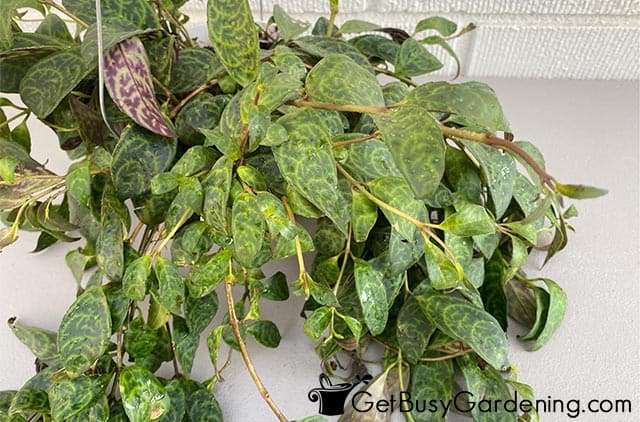
How To Grow Lipstick Plant ‘Black Pagoda’
Before we chat about Aeschynanthus ‘Black Pagoda’ care, first we need to learn where to grow it. It’s important to choose the best location to set it up for long-term health.
Hardiness
One of the reasons they’re more commonly grown as houseplants is that they are not cold hardy at all. They can only survive outdoors year round in zones 10-11.
In colder regions they’re best kept indoors, or overwintered in a sheltered location when the temperatures drop.
Where To Grow Black Pagoda Lipstick Plant
If you live in a warm enough climate, you can grow your Black Pagoda lipstick plant outdoors year round.
They can live in the branches of trees, or a full shade location either in the garden or in a pot with good drainage.
For the rest of us, they do better as houseplants where temperatures remain above 60°F. They need somewhere with moderate, indirect light away from any heating vents or drafts.
The trailing nature of their branches makes them popular for hanging baskets or shelves where they can drape down.
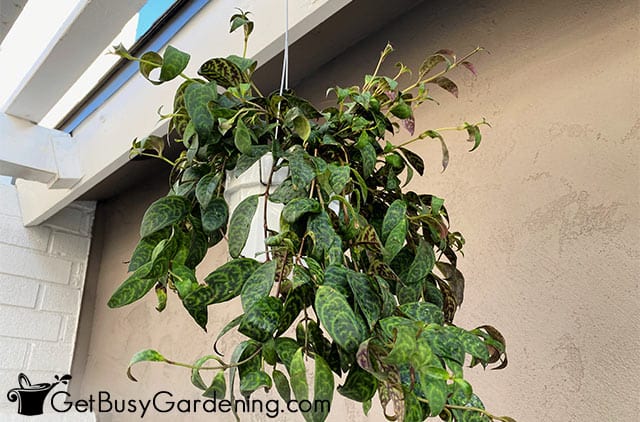
Black Pagoda Lipstick Plant Care & Growing Instructions
Now that you know where to grow it, let’s talk about Black Pagoda lipstick plant care. These tips will teach you everything about keeping it in good health.
Light
As long as you keep it out of direct sun during the hottest part of the day, they can handle a wide range of light, from low to bright.
Aim for 5-6 hours of moderate to bright diffused light. An ideal spot is a few feet away from a south-facing window.
Direct sun in the morning or evening is okay, but for no more than 2 hours, or the leaves may scorch.
Water
They can tolerate periods of dryness fairly well, but can suffer root rot if left moist for too long.
Wait until the soil is dry 2” down or more, then water deeply until it is moist but not soggy. Always drain away any excess right away, and never leave the pot soaking.
Overwatering is one of the most common issues, so use a moisture meter if you have trouble knowing when to give it more.
Humidity
As a tropical plant, lipstick Black Pagoda prefers average to high levels of humidity. They’ll thrive in 50-60%, which you can track with a monitor. But they’re very tolerant of dry conditions as well.
If your air is dry indoors, set up a small humidifier, a pebble tray with water, or occasionally mist the leaves.
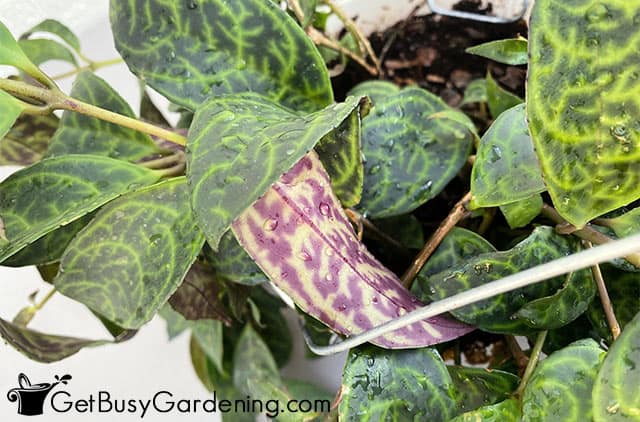
Temperature
The ideal temperature range is between 65-85°F, which makes them perfect for indoor environments. They don’t like sudden fluctuations, so keep them away from heaters or drafty vents.
Below 60°F may trigger yellowing leaves. When it drops below 50°F, the plant can suffer leaf drop, frost damage, and eventually death.
They can tolerate higher heat, but will need more frequent watering and a full shade environment.
Fertilizer
It is a good idea to feed your Black Pagoda lipstick plant once it’s done flowering to stimulate healthy new foliage growth.
Use a balanced granular fertilizer once a month during the spring and summer, or a diluted liquid option, like fish emulsion or compost tea, every other week.
Soil
As an epiphyte, Aeschynanthus ‘Black Pagoda’ technically doesn’t need soil to grow. They can live on trees, or in a soilless medium like coco coir or orchid bark.
But they do well in containers with soil too. An aroid mixture is ideal, or make your own by combining 2 parts regular potting soil with 2 parts perlite and 1 part pine bark.
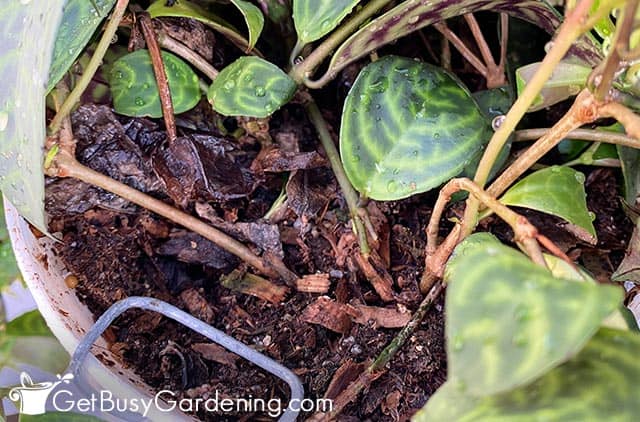
Repotting
You won’t need to repot your Black Pagoda lipstick plant very often. They like being root-bound, and frequent repotting can shock and damage them.
So only move them into a container one size larger only when they’re severely pot-bound.
You’ll know it’s time when you see roots growing through the drainage holes. It’s best to do this in the spring or summer.
Pruning
Regular pruning is a great way to achieve bushier, full growth, and keep them healthy.
Wait until yours is done flowering in the spring. Then use a sharp pair of clean precision pruners or micro snips to deadhead spent blooms, remove any dead leaves, and trim leggy branches.
Make your cuts just above a healthy set of leaves to encourage branching.
Pest Control Tips
Healthy Black Pagoda lipstick plants rarely have issues with pests, but occasionally they can experience mealybugs, thrips, spider mites, aphids, scale, or whiteflies.
Begin treatment as soon as you notice the infestation. Use a cotton swab dipped in rubbing alcohol to directly remove any visible bugs.
Organic insecticidal soap is effective as well, or you can make your own by combining 1 teaspoon of mild liquid soap with 1 liter of water. Neem oil can be a helpful long-term solution.
Black Pagoda Lipstick Plant Propagation Tips
Aeschynanthus ‘Black Pagoda’ is easy to propagate using stem cuttings.
Take a healthy branch cutting in the summer when flowering has finished, and dip it into rooting hormone.
Place it in a damp, loamy medium, and put it someplace where it will get bright light. Keep it moist and warm, and roots should form in a matter of weeks.
Learn all about how to propagate your lipstick plant step by step here.
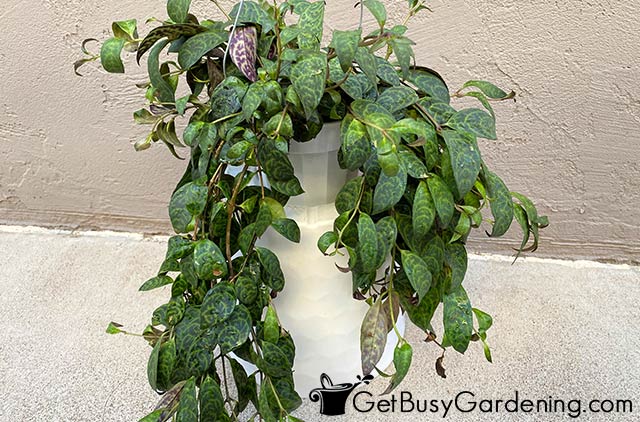
Troubleshooting Common Problems
The Black Pagoda lipstick plant is known for being low maintenance. But over the years you may run into one of these more common issues. Use my tips to get it back into healthy shape.
Leaves Turning Yellow
Yellow leaves can be a sign of different issues, such as overwatering, cold temperatures, or a nutrient imbalance.
Make sure you let the soil dry out between waterings. Use a moisture meter to help if you have trouble with overwatering.
Keep them above 65°F, and use a balanced fertilizer to provide plenty of nutrients in spring and summer.
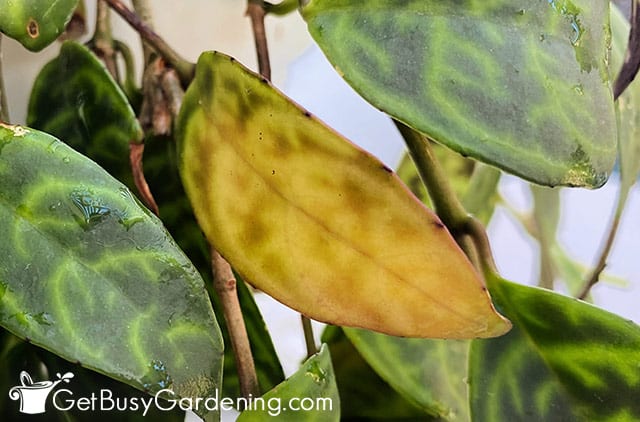
Leaves Curling
Curling leaves are a sign of improper watering, nutrient imbalance, frost damage, lack of light, or pests.
Keep them in moderate to bright, indirect light somewhere warm, and check for any signs of bugs. Don’t leave them in soggy soil, but try to avoid extended periods of drought too.
Brown Leaves
Brown leaves can be caused by sunburn, severe root rot, under watering, or a nutrient imbalance.
Fertilize them throughout the growing season, ensure they get even moisture, and keep them out of direct sunlight.
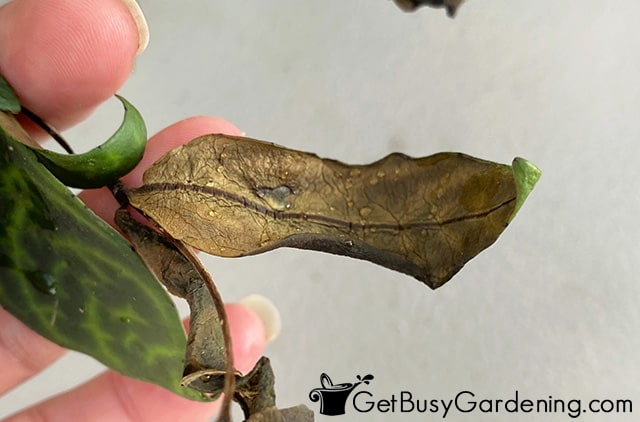
FAQs
Here I’ve answered some of the most commonly asked questions about Black Pagoda plant care. If yours isn’t listed, please add it to the comments section below.
Is a Black Pagoda lipstick plant easy to care for?
Yes, a Black Pagoda lipstick plant is easy to care for when you understand how to create its ideal growing environment. Provide plenty of indirect light, and a warm, constant temperature.
Is a Black Pagoda lipstick plant a hoya?
No, a Black pagoda lipstick plant is not a hoya. The two look very similar, but they are in fact from a different plant genus and family.
How much sun does a Black Pagoda lipstick plant need?
A Black Pagoda lipstick plant needs 5-6 hours of indirect sun per day. It can tolerate direct exposure in the morning or evening for a few hours, but will burn in the harsher afternoon rays.
Is Black Pagoda lipstick plant toxic?
No, the Black Pagoda lipstick plant is not toxic to pets or people.
Does the Black Pagoda lipstick plant flower?
Yes, the Black pagoda lipstick plant will flower once it’s reached maturity at around 4-5 years old. Blooms will emerge from branch tips of healthy plants during late winter or spring.
Now that you know the ins and outs of Black Pagoda plant care, you’ll be able to add one to your houseplant collection with confidence. Even a beginner can keep it thriving with these tips.
If you want to learn all there is to know about maintaining healthy indoor plants, then you need my Houseplant Care eBook. It will show you everything you need to know about how to keep every plant in your home thriving. Download your copy now!
More Houseplant Care Guides
- Growing Plants Indoors – The Ultimate Guide
- How To Care For Goldfish Plant (Nematanthus gregarius)
- How To Care For Cat Palm (Chamaedorea cataractarum)
- Christmas, Thanksgiving, & Easter Cactus: How To Tell Them Apart
- How To Care For Chinese Money Plant (Pilea peperomioides)
- How To Care For A Spider Plant (Chlorophytum comosum)
Share your black pagoda lipstick plant care tips in the comments section below.
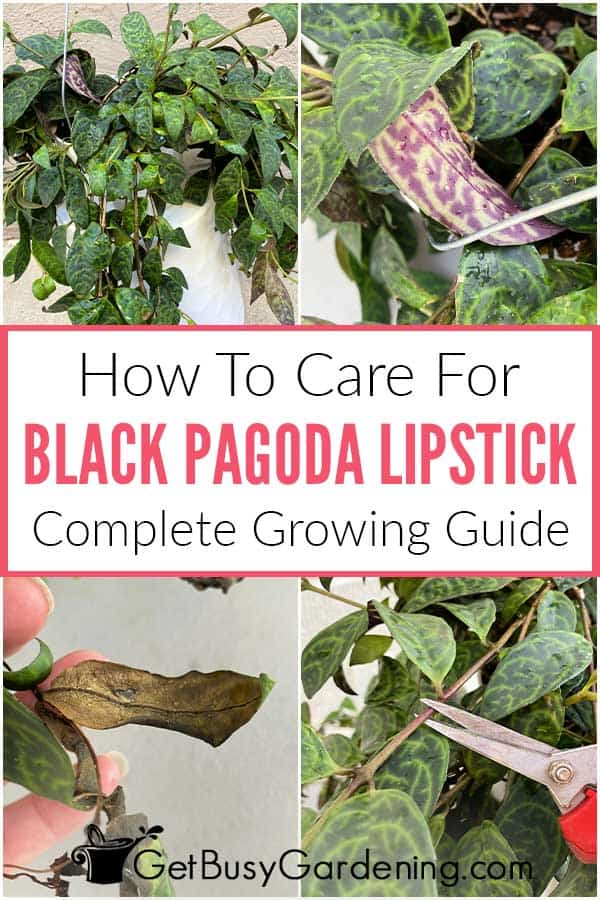
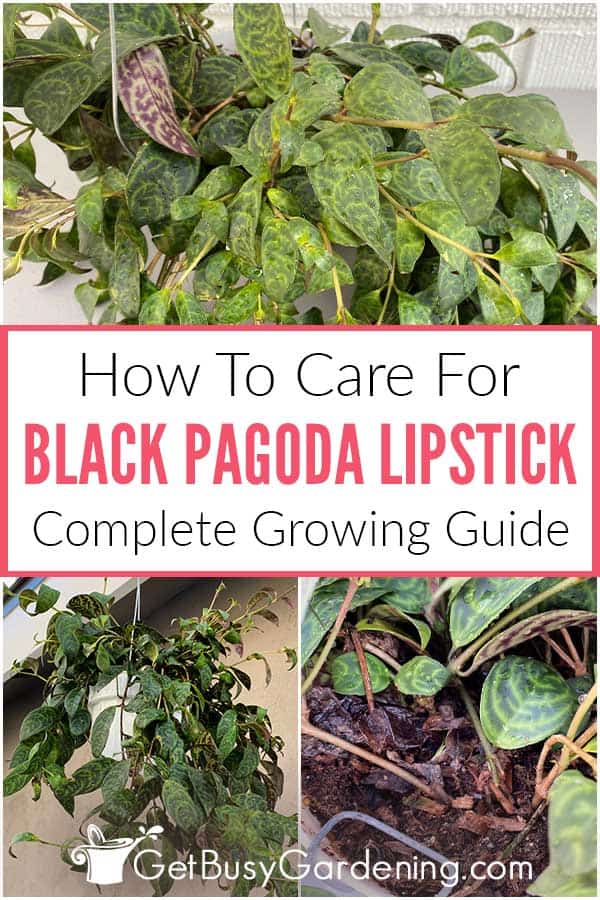
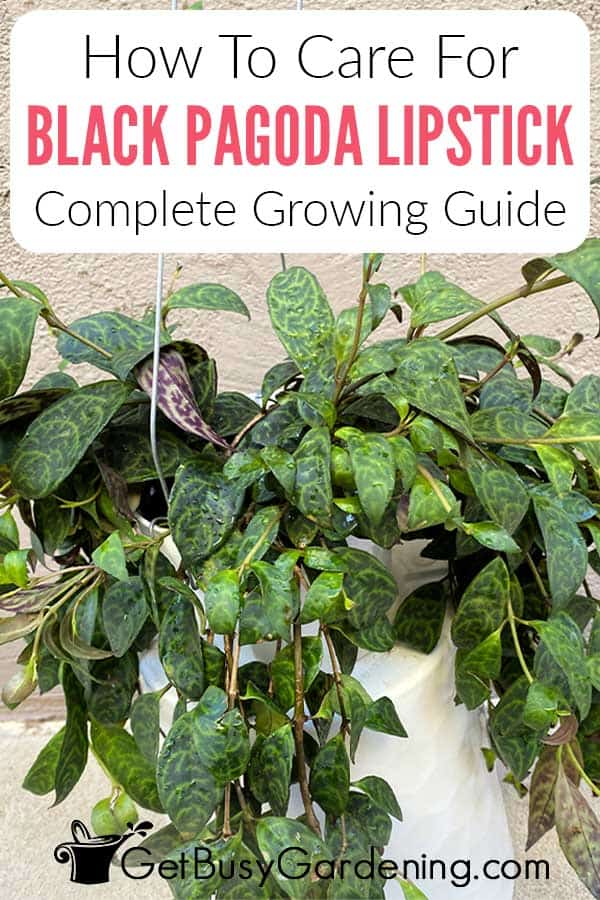

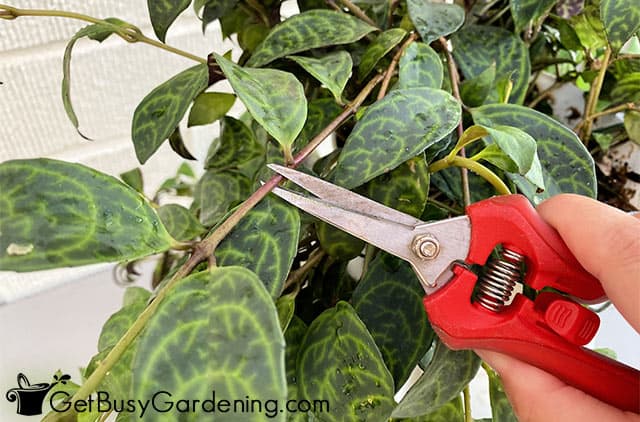


Leave a Reply